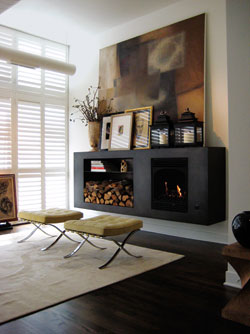 |
|
A large painting and a casual arrangement of smaller pieces top a fireplace designed and fabricated by Randall Kramer (kramerdesignstudio.com) for homeowners Thomas Job and Peter Perrodin. |
How many times have you been told that when buying art, you should follow your heart? That if you feel passionate about a piece, you’ll find a way to make it work? This is good advice, but it doesn’t go far enough.
You may love something on a bare wall in a well-lighted shop or a gallery, or even online, but how can you be sure you’ll love it as much once you get it home? And how do you decorate around it if you’re not sure what you’re doing? We asked some design experts for advice.
(1) Don’t be afraid to go big. A single large piece—say, four by five feet—is more dramatic than several smaller ones. “A lot of people are afraid of where they’re going to put a big piece again if they move,” says Michael LaConte, owner of Homey (3656 N. Lincoln Ave., 773-248-0050), a North Center gallery that specializes in af-fordable art. But he thinks the virtues of size outweigh hypothetical problems down the road. “Have a great piece so that as you walk into the room, it sets the tone,” he advises. A big giclée print, which uses a digital process to re-create a painting or photograph with paint pigment rather than ink, is a way to do this without going into debt. Giclées generally go for a small fraction of the cost of the original and are available from many emerging artists. And unlike a poster, a giclée print on canvas or ragstock looks almost like the real thing.
(2) Add sculptural elements. Neglecting the three-dimensional will make a room feel flat. Sculpture can be anything from a piece you buy in a gallery to an antique urn filled with bamboo stalks. Think outside the box about placing sculpture around a room. “Create interest by bringing the eye up to the top of an armoire or a mantel or a bookcase,” advises Wilmette-based interior decorator Laura Soskin (Laura Soskin Design, 847-525-9955). “Don’t be afraid to lean art in a layered montage with a variety of sculptural pieces, such as lamps, vessels, or objects from nature.”
Photography: Peter Perrodin
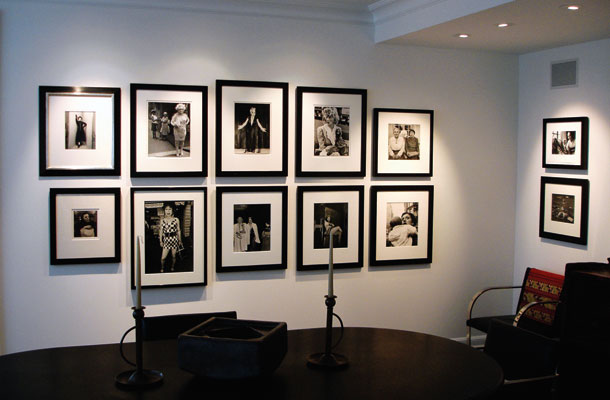 |
|
Spencer-Witczak art installers (theartofinstallation.com) designed this Gold Coast apartment’s black-and-white photography display so that it can evolve as the collection grows |
(3) Definitely mix styles and materials. Combining not only modern and traditional art but also different media—photography, oil painting, watercolor, fiber art—makes a room dynamic and interesting. One key to making it succeed is to choose pieces with a similar, but not identical, range of colors and tones. “It’s not so much about the images you’re putting next to each other,” LaConte says. “It’s that the palette works.”
(4) Maintain balance. A single modern painting hung in an otherwise traditionally furnished living room can look off kilter. Establish a more equal representation of both styles, whether that means adding pieces of avant-garde art, some chairs with contemporary lines, or accessories—with a modern edge.
(5) Choose black-and-white photography. It works in any environment, from austere contemporary to classic romantic. Stick with subjects that aren’t likely to become dated; nature and architectural scenes are good bets. Hanging black-and-white photos on colored walls gives both the walls and the photos an extra pop, LaConte says.
Photography: Peter Perrodin
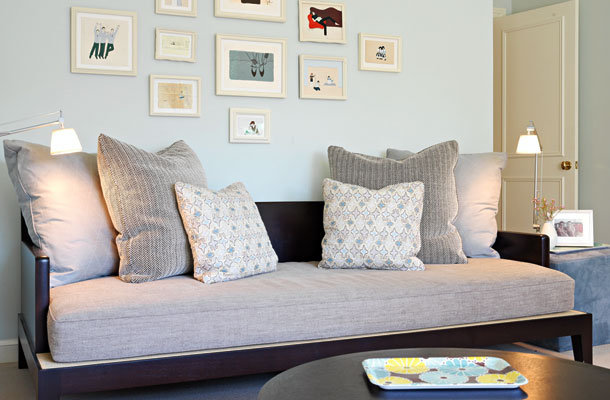 |
|
In the media lounge of this Lincoln Park residence, designer Kara Mann maximized the impact of ten small paintings by the same artist by grouping them over a daybed. She added texture to the display by using a variety of off-white frames |
(6) Create a group from small pieces. Scattering small pieces around a room can diffuse their impact, says Chicago-based interior designer Kara Mann (Kara Mann Design, 312-893-7550). Instead, create the feeling of a larger installation by hanging them together.
(7) Keep frames and mats simple. Get rid of ornate, gilt frames, even around traditional pieces. Soskin points out that a clean-lined frame and a neutral-toned mat give a fresh edge to classic art and are unlikely to detract from the piece. If you’re trying to mix different styles within the same palette, take the pieces to a good framer for advice on getting the pieces to play well together.
(8) Opt for neutral furniture. Blending a bold sofa with eye-popping art requires a practiced eye. Choosing furnishings with clean lines, muted colors, and subtle patterns creates less room for decorating errors while keeping the focus on the art and giving you more flexibility to swap out pieces.
Photography: Peter Perrodin
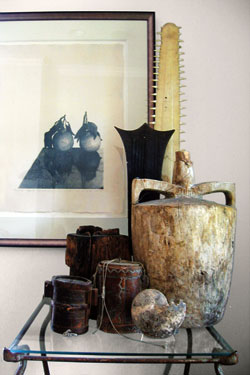 |
|
Don’t neglect the three-dimensional. Groupings of objects—like this one done by designer Laura Soskin—work better than a scattering. |
(9) Edit what you own. “People have a hard time detaching from things they loved previously,” LaConte says. “They’ll have great new furniture but old poster art or old tchotckes. Stay fresh; get rid of things that are old and dated.”
(10) Hang art at an appropriate height. Too many people hang art so high, it appears to be floating away. In general, the center of a piece of art—or of an arrangement—should be five and a half feet from the floor, Mann says. If pieces are small and finely detailed, make sure viewers can get close enough to appreciate them.
(11) Rotate your art every year or so. Your eye stops noticing the over-familiar. Plus, adds Trisha London, owner of the boutique Zella Brown (1444 N. Milwaukee Ave., 773-276-1746), “when people have limited wall space, it’s nice to have the versatility to bring things in and out—until you have that giant dream home, where you can fill all the walls.”
Photography: Peter Perrodin
Go-to Artists
Nate Berkus
Oprah regular, author of Home Rules, and XM radio show host
Ross Bleckner Large-scale oil paintings; rbleckner.com; available at Mary Boone Gallery, 745 Fifth Ave., New York; maryboonegallery.com
Michael Hainey Black-and-white paintings depicting birds and incorporating thought-provoking phrases; michaelhainey@gmail.com
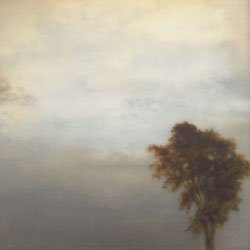 |
|
“Untitled #3949” (detail), oil and beeswax on canvas over panel, 10" x 8" |
Bruce Fox
design director,
Heather G. Wells, Ltd.
Hiro Yokose Ethereal oil and beeswax landscape paintings
Matthew Brown Oil and balsam paintings of landscapes, plants, and birds
Both available at Carrie Secrist Gallery, 835 W. Washington Blvd., 312-491-0917; secristgallery.com
Photography: Peter Perrodin
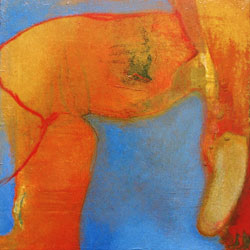 |
|
“Red Ropes,” oil on canvas, 17" x 17" |
Michael LaConte
owner, Homey gallery
Paul Lorenz Colorful abstract oils; paullorenz.biz
Marketa Sivek Oil paintings in rich
colors, representational or abstract; marketasivek.com
Both available at Homey, 3656 N.
Lincoln Ave., 773-248-0050;
ilovehomey.com
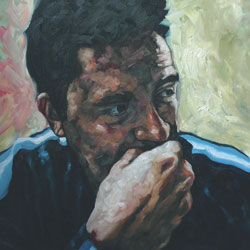 |
|
“it’s not you, it’s me” (detail), oil on canvas, 40" x 60" |
Trisha London
owner, Zella Brown
Gabriel Mejia Studies of faces,
some in pen and ink, others in oil;
gabrielmejia.com
Matthew Sabo Dramatic color photographs of everyday objects; flickr.com/people/mattsabo17
Kimberly Creswell Colorful abstract encaustics and acrylics on wood;
kimberlycreswell.com
All available at Zella Brown, 1444 N.
Milwaukee Ave., 773-276-1746; zellabrown.com
 |
|
“Belmont Rocks,” photograph, 51⁄4" x 37" |
Laura Soskin
Laura Soskin Design
Michael McGuire Panoramic photography of Chicago and natural settings; 773-528-4593; mmcguire.net
Frank Fruzyna Dramatic abstract paintings infused with color; 312-492-7711; fruzyna.com
Jeffrey Janson Black-and-white and natural-hued landscape paintings;
312-929-3144; jeffreyjanson.com
Photography: Peter Perrodin


